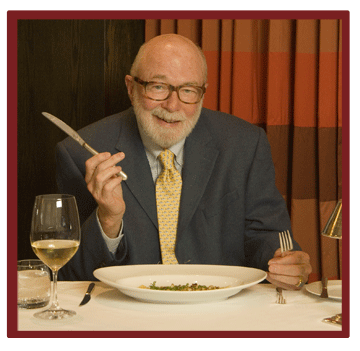|

|
|
|
|


|
|
|
Manna for Mortals
A food critic recalls his finest moments / Elliott Mackle 77G
"You won’t like these,” my brother said, popping a last morsel of strawberry tartlette into his mouth. “So I’d better finish them up.”
The occasion? A picnic in a sunny meadow in the foothills of the French Pyrenees some thirty-five years ago. Passing through the provincial capital, Pau, earlier that day, my brother, his wife, and I stopped to purchase a wedge of local cheese, shaved ham, a crusty baguette, mineral water, and several tarts topped with wild berries.
My brother reached for a second tart. The resigned, disappointed look on his face faded. In its place, veiled anticipation mixed with just a hint of gotcha.
“Not so fast,” I said. “I’d better try one of those.”
The woodsy, naturally sweet berries, the eggy evanescence of the underlying pastry cream, the rich, yielding crispness of the buttery crust were perfect in themselves, unforgettable in combination. “You won’t like this” became a family byword for wow-is-this-delicious, step-back-Escoffier, bring-it-on-Julia feasts, dishes, and sips.
As a grad student in Emory’s Institute of Liberal Arts in the 1970s, I studied utopia, the criticism of society and search for earthly perfection. Later, as a professional critic, seeking out and documenting the world’s best food for the Atlanta Journal-Constitution, the Los Angeles Times, Food and Wine, Travel and Leisure, and radio and television, I applied similar standards when recommending chefs and restaurants. That perfect French tart—the name of the bakery is lost in time—became the standard by which I judge all fruit tarts. Here are some further high points of my subsequent investigations.
Crossing from New York to Europe on the Italian luxury liner Rafaello in 1974, grazing the midnight buffet on a stormy November night, I encountered a complex, urbane pastry to match the summer simplicity of the fruit tart. Gateau Saint-Honoré, named for the patron saint of bakers, combines the principal arts a pastry cook must master. It is thus a kind of final exam or showpiece. Saint-Honoré consists of a base of short crust or puff paste ringed with choux—round éclairs—that are glazed with caramel and sometimes filled, perhaps with crème café. The center is mounded with glazed, vanilla-scented crème Chiboust or crème Chantilly, the whole veiled in angel hair spun by hand from boiling sugar. Only a brave, highly skilled baker attempts it. To turn out a perfect version aboard a rolling, pitching ship seemed a miracle. Heaven was not too strong a word for every bite.
Chefs perform feats at which we mortals can but marvel. In their hands ordinary ingredients are transubstantiated into culinary manna. Vegetables, in my experience, are the most difficult subjects on which to practice such magic.
Frank Stitt III, owner-chef of Highlands Bar and Grill in Birmingham, Alabama, French-trained and Southern-bred, served me an English pea flan I can still taste a decade later. When I mentioned the flan at a food festival last year, he shrugged and shyly smiled. “Ah, yeah,” he answered. “We ought to make that again sometime.”
Anne Quatrano and Clifford Harrison, co-owners of Atlanta’s top-ranked Bacchanalia, may be the world’s top cauliflower chefs. My one-word note on their cauliflower custard: “spectacular.” A bisque combining cauliflower, chives, shaved black truffles, and truffle oil, served three years earlier at their comparatively downscale bistro, Floataway Café, reminded me of warm cream infused with smoky, musty memories.
I’ve never liked red bell peppers. Guenter Seeger, then cooking at the Ritz-Carlton Buckhead, created a red-pepper soufflé that I lapped right up. Lima beans? My father threatened the eight-year-old critic and ordered him to swallow a mouthful of overcooked mush. Daddy failed. But when television chef Nathalie Dupree, a longtime friend and colleague, tossed baby limas in warm butter and fresh herbs and put them on my tongue with her own hands, I saw, and tasted, the light.
Barbecue sauce on grilled fish? Who knew? Frank Lee, chef at Slightly North of Broad in Charleston, South Carolina, thought that one up. One bite convinced me. The ultimate secret to really memorable Georgia barbecue pork? Judicious observation revealed the key. At what I judge to be the best smokehouse in the state, Vandy’s Barbecue in downtown Statesboro, hunks of savory, slow-cooked pork butts are hand-chopped moments before serving, instantly loaded onto grocery-store white bread, and rushed to the table, the juices still running.
Cauliflower and ’cue are hardly the whole nine yards. In my life I’ve had two perfect meals. The first was at the cramped, low-ceilinged Restaurante Los Caracoles (“the snails”) in Barcelona’s Gothic quarter near the cathedral. It began with chilled Spanish melon, smooth, kicky, yet sweet as a dessert wine; continued with snail-shaped rolls and butter; climaxed with an aromatic paella thick with ham, mussels, shrimp, chicken, fish, and saffron-scented rice cooked over an open fire twenty feet from our table; and concluded with crème Catalan, caramel custard topped with sugar and glazed with a red-hot salamander.
Closer to home, lunch at the equally famous and dependable Joe’s Stone Crab Restaurant in Miami Beach was a summation of the early influences of my hometown: iced, cracked crab claws with two dipping sauces, mustard-spiked mayonnaise and melted butter; hash brown potatoes, crisp and rich; Cole slaw, ditto; and key lime pie with a Graham cracker crust and a whipped cream crown.
My utopian eatery? Desert-island menu? Last meal? During a restaurateurs’ conference several years ago, I was among a panel of critics asked just that. Several of the world’s best restaurants came to mind. I’ve dined superbly at such starry icons as Taillevent in Paris, Le Bernardin in New York, Galatoire’s in New Orleans, the Oriental Hotel in Bangkok, and London’s Savoy Grill.
I didn’t hesitate: Zuni Café, on Market Street, San Francisco. Late lunch on a clear, crisp day. A table by a window. The classic American spread: Caesar salad, none better; a heap of salty shoestring fries, the best I know; a thick beef burger, cooked rare. Very rare.
But never mind. Trust me. You wouldn’t like it.
One Word: Fresh. Ask Executive Chef Linton Hopkins 92C about his philosophy for his renowned Atlanta eatery Restaurant Eugene, and he might wax poetic about the rutabaga, quote painter Paul Cezanne about carrots and revolution, and describe his new favorite technique of poaching in corn milk—all before you can say “in season.” Fresh food drives the menu at Restaurant Eugene, where Hopkins buys many ingredients directly from local producers and serves vegetables and fruits at the peak of ripeness. “As a chef, I want the best ingredients, picked from the earth the day before or the day they go on the plate,” he says. “That freshness just can’t be matched.” Hopkins majored in anthropology at Emory and was headed for medical school (his father, Linton Hopkins 73MR, is a professor in the School of Medicine) until he realized he could make a life as a chef. “I discovered it was a profession with a great lineage and history,” he says. “I could do something I absolutely loved with my life, and I never looked back.”
••••••••••••••••••••••••••••••••••••••••••••
Chef Linton Hopkins’s Chanterelle Risotto
Serves 6
1c. superfino Arborio rice
½ c. dry white wine
3 c. chicken stock
1 small yellow onion, minced
3 tbl. olive oil
3 tbl. whole butter
2 c. sliced chanterelles
(or the best mushrooms available)
½ c. freshly grated parmesan
zest of one lemon
salt and pepper to taste
Method
Sauté chanterelles in 1 tablespoon butter until liquid released. Remove from heat and reserve. In a saucepan, sauté onion until translucent, add rice, and stir until well coated. Add white wine and stir until absorbed.
Add chicken stock in thirds, stirring until each amount is absorbed. When the rice is cooked through but still al dente, add chanterelles. Remove from heat; stir in remaining butter, cream and zest. Season to taste.
|
TOP
|
|
| |
©
2007 Emory University
|
 |
 |
 |
 |
 |
|